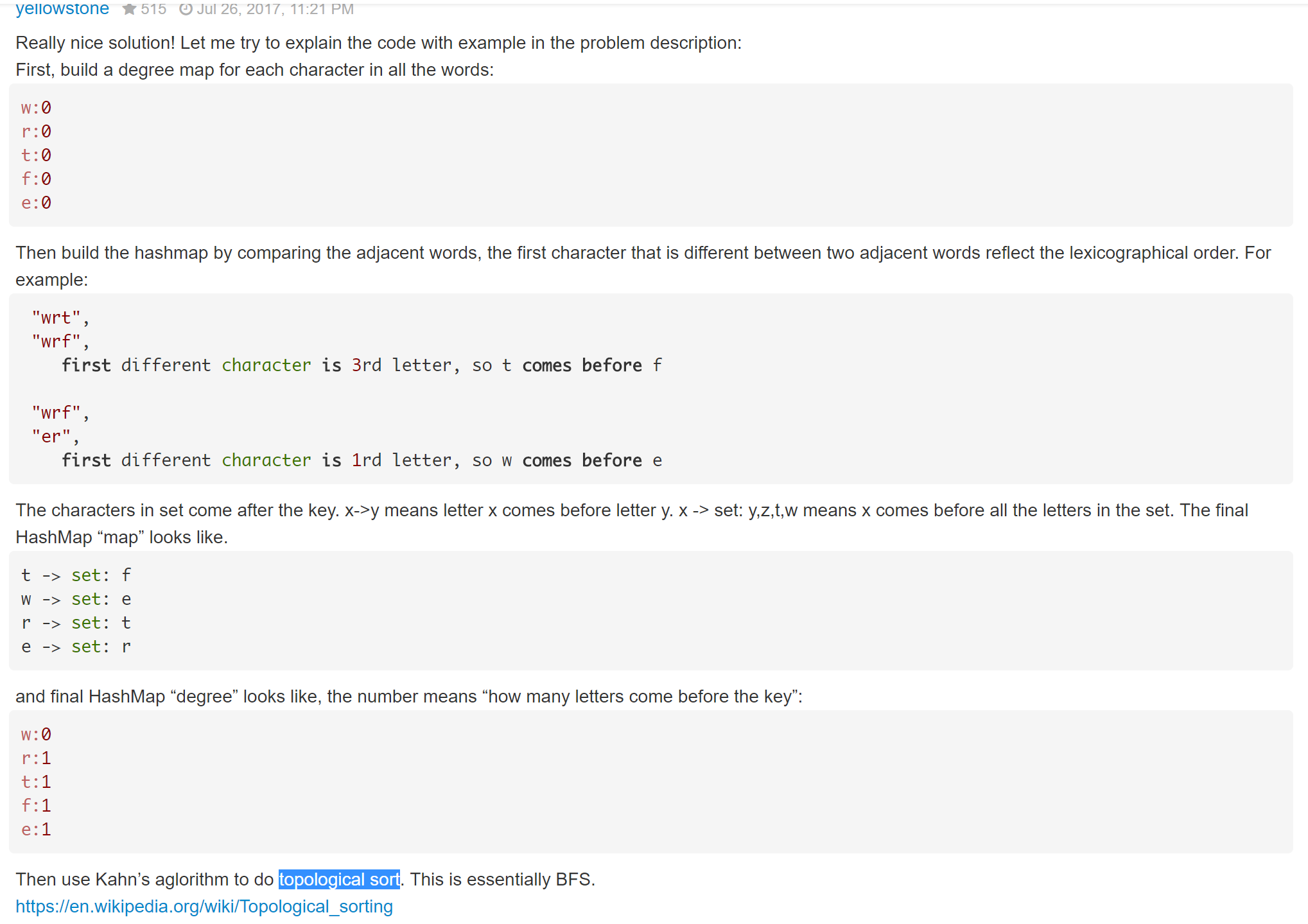269. Alien Dictionary (Hard)
There is a new alien language which uses the latin alphabet. However, the order among letters are unknown to you. You receive a list of non-empty words from the dictionary, where words are sorted lexicographically by the rules of this new language. Derive the order of letters in this language.
Example 1:
Given the following words in dictionary,
[
"wrt",
"wrf",
"er",
"ett",
"rftt"
]
The correct order is:"wertf".
Example 2:
Given the following words in dictionary,
[
"z",
"x"
]
The correct order is:"zx".
Example 3:
Given the following words in dictionary,
[
"z",
"x",
"z"
]
The order is invalid, so return"".
Note:
- You may assume all letters are in lowercase.
- You may assume that if a is a prefix of b, then a must appear before b in the given dictionary.
- If the order is invalid, return an empty string.
- There may be multiple valid order of letters, return any one of them is fine.
Solution 1: BFS, Topological Sort O(n * L); O(|V|+|E|) = O(26 + 26^2) = O(1)

/**
* Graph. Topological Sort. BFS.
* Two steps:
* 1) Build a graph and in-degree from the given words.
* 2) Do topological sort.
* <p>
* Topological sort based on Kahn's algo.
* It needs a graph and each node's in-degree.
* Then start with all 0 in-degree nodes, enqueue them.
* While the queue is not empty, dequeue a node and add to result order.
* Remove edges start from this node by reducing the in-degree of its neighbors.
* If those nodes become 0 in-degree as well, enqueue.
* When queue is empty, it's done.
* Before return, check if the order is valid by comparing the result length with # of graph nodes.
*/
public String alienOrder(String[] words) {
if (words == null || words.length == 0) {
return "";
}
Map<Character, Integer> inDegrees = new HashMap<>();
for (String s : words) { // Init in-degree of all characters given to 0.
for (char c : s.toCharArray()) {
inDegrees.put(c, 0);
}
}
Map<Character, Set<Character>> graph = new HashMap<>(); // Use set to avoid duplicate edge.
for (int i = 0; i < words.length - 1; i++) { //遍历单词数组
String w1 = words[i];
String w2 = words[i + 1];
if (w1.startsWith(w2) && w1.length() > w2.length()) { // "abcee" -> "abc", invalid.
return "";
}
for (int j = 0; j < w1.length() && j < w2.length(); j++) { //遍历单词String
char c1 = w1.charAt(j);
char c2 = w2.charAt(j);
if (c1 != c2) {
if (!graph.containsKey(c1)) {
graph.put(c1, new HashSet<>());
}
if (graph.get(c1).add(c2)) {
inDegrees.put(c2, inDegrees.get(c2) + 1);
}
break; // Should break once one edge is found.
}
}
}
Queue<Character> queue = new LinkedList<>();
for (Map.Entry<Character, Integer> e : inDegrees.entrySet()) {
if (e.getValue() == 0) queue.offer(e.getKey());
}
StringBuilder order = new StringBuilder();
while (!queue.isEmpty()) {
char n = queue.poll();
order.append(n);
// Remove edges from graph by updating in degrees of neighbors.
if (graph.containsKey(n)) { // Avoid NPE.
for (char neighbor : graph.get(n)) {
inDegrees.put(neighbor, inDegrees.get(neighbor) - 1); // Update in degree.
if (inDegrees.get(neighbor) == 0) { // Add 0 in degree node to queue.
queue.offer(neighbor);
}
}
}
}
return order.length() == inDegrees.size() ? order.toString() : ""; // Check if all nodes are in result.
}